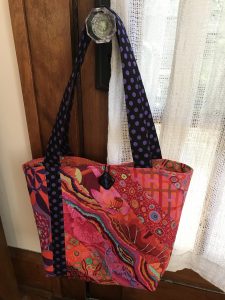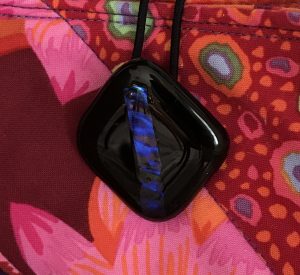 Shall we admit that I’m a pushover for a clearance sale? Even when I have a lot of fabric that is perfect for making a cute bag, I still follow the links in the Craftsy emails I get. Must get help to beat this addiction!
Shall we admit that I’m a pushover for a clearance sale? Even when I have a lot of fabric that is perfect for making a cute bag, I still follow the links in the Craftsy emails I get. Must get help to beat this addiction!
It’s opera season at the university where I work as a collaborative pianist. So my time is not my own. But last week we had a day off between final dress rehearsal and first performance. I grabbed that time, preceded by a couple of stolen hours on Easter weekend, to make the opportunity to sew. And waiting in the wings was the Three Quarter Patch Tote Kit I had snagged off Craftsy for a mere $13.20, plus shipping. I could not have bought the Kaffe Fassett fabric for that little, much less the fabric and a pattern.
 I’ve made a lot of bags in the past couple of years, and once starting on this bag, I was glad I had the experience. With apologies to designer Pamela Hastings (with whose work I am unfamiliar), the instructions for this bag are not well written. The pattern is marked Intermediate experience level. But it’s a simple bag and could easily be a beginner bag if the instructions were clearer.
I’ve made a lot of bags in the past couple of years, and once starting on this bag, I was glad I had the experience. With apologies to designer Pamela Hastings (with whose work I am unfamiliar), the instructions for this bag are not well written. The pattern is marked Intermediate experience level. But it’s a simple bag and could easily be a beginner bag if the instructions were clearer.
 Before beginning the bag, I searched online for comments by other sewists. I read Sandra Walker’s pattern review on her blog, “Musings of a Menopausal Melon,” and was glad I did. Based on my skillset going into the project, Sandra’s notes, and my experience making this bag, here’s what I would amend in the instructions and in the sewing.
Before beginning the bag, I searched online for comments by other sewists. I read Sandra Walker’s pattern review on her blog, “Musings of a Menopausal Melon,” and was glad I did. Based on my skillset going into the project, Sandra’s notes, and my experience making this bag, here’s what I would amend in the instructions and in the sewing.
- The fabic is beautiful but thin. It seems not to be the standard quilting-weight cotton I’m used to, which surprised me. I enjoy Kaffe Fassett-designed fabrics and have since first seeing an exhibition of his work outside Stockholm in 2000. But this fabric needs interfacing if you’re making a bag that will be stuffed with your stuff and toted around. Pellon SF101 needs to be a staple in a bagmaker’s stash. I interfaced the lining pieces and the straps with SF101.
- The step about stitching the strips together wasn’t clear. If you look at Sandra Walker’s blog post, her picture makes it appear she sewed each set of two strips together on the short end so she had five long strips, then sewed those together on the long edges. I just made two sets of five strips sewing along the long edges. Then I cut one exterior panel on the diagonal from each of those. When I cut, I positioned the rectangles so one was at a 45° angle this way “/” and the other mirrored this way “\”. Looking at Sandra’s picture, she cut hers both the same way (which may have been necessitated by her sewing all the strips into one piece rather than my two pieces).
- After assembling the front and back exterior panels, I stitched-in-the-ditch on the diagonal strips, topstitched a couple of lines down the polka dot stripe, and then quilted the floral side strip, following Sandra Walker’s suggestion in her blog post. Honestly, that was my least favorite part. I remembered why I have a local long-arm quilter do the “dirty work” on any quilts I make: she enjoys that; I do not. If you enjoy the quilting process, knock ourself out. If not, just stitch a couple of vertical lines on that section to give the bag exterior more body.
- Do not cut out your lining pieces until completing the quilting step. “Square up” (Carefully measure the finished quilted front and back and use your plastic ruler and rotary cutter to make it a perfect rectangle. Then stack them right sides together and, if necessary, trim to make ensure they’re the same size.) your front and back, then use one as the pattern for the lining pieces. Sandra Walker had mentioned the lining was a little big for the bag, but I forgot that when making this bag. The lining is, indeed, big. Alas, I’m not going back to fix that!
- For the straps, I was glad I had read Sandra Walker’s post. As stated before, I interfaced with SF101. Then, after folding the straps as instructed, I cut two ¾” strips of a lightweight cotton batting and slipped in inside the folds. (To be clear: To make the strap, you fold the straps in half lengthwise and press, then open the strip and fold each long edge inward to meet the fold and press again. I then opened it and placed my batting strips next to the center fold on each strip, then refolding, pressing very well, and topstitching close to each long edge.
- Strap placement. The instructions tell you to measure 5″ in from either side on the top (long edge) of the exterior panels. But they don’t say where to position the straps on that—butt it to the right, butt it to the left, or center? Taking a clue from the polka dot stripe on the panel, I centered the straps on the 5″ mark. It’s a nit, but it makes the difference between a beginner level bag (as this should be) and an intermediate bag.
- I skipped the tab closure part. Years ago I started using elastic ponytail bands instead of fabric straps to hold tote bags closed. I like the give of the elastic when I’ve got an overstuffed bag (as mine always are). They come in a variety of colors at your corner drugstore.
- In steps 18 and 19 of the “Tote Assembly” section, the instructions tell you to box the corners of the bag. But they don’t tell you to trim off the excess. That’s a whole lot of excess fabric to have hanging around inside the bag. Step 19A should be to align the ¼” line on your plastic ruler with the stitching line from step 19, trimming off the excess triangle of fabric. Then zigzag the ¼” seam allowance. Do this also when boxing the lining. If you only have a straight-stitch machine, the zigzag finishing is not absolutely necessary, but it just gives you a nicer finish inside the bag and keeps the seam allowance from fraying.
- I had cut out all the pieces on Easter weekend and done the exterior panel stitching. When I got to my free sewing day on Thursday, I realized I hadn’t cut out the pocket pieces. If there was enough fabric left after cutting the lining pieces, I have no idea where I put it. So I took the scraps of the stitched strips and cut a diagonal rectangle and a vertical-pieced rectangle. There were not the prescribed size of the pocket, but I think they actually made a larger pocket than the pattern calls for. And they’re cute against the lining fabric. ☺
- My last modification would be to trim all the ½” seam allowances down to about ¼”. I didn’t do this. When I was topstitching the edge as the final step before applying Scotchgard®, I was wishing I had.
- Sometimes I make a reinforcement for the bottom to help it stand up. I measure the boxed bottom and cut a piece of plastic canvas to those dimensions. Then I take some of the excess fabric for the bag and make a little “pillowcase” for the plastic canvas rectangle, slipping the plastic inside the “pillowcase” and then edgestitching it closed. If I were going to use this bag on a regular basis, I would include that step. But I’m not in love with the bag, and am not sure how much I’m going to use it. Plus I just wanted to get it done and off my list. #badattitude
 Pulled a cool fused-glass button out of my stash for this bag. I picked it up at one of the bead shows at the Tucson Gem & Mineral Show around 2004 and am thrilled to finally be able to use it.
Pulled a cool fused-glass button out of my stash for this bag. I picked it up at one of the bead shows at the Tucson Gem & Mineral Show around 2004 and am thrilled to finally be able to use it.
The kit on Craftsy is sold out now. I don’t know if they’ll restock. Hancock’s of Paducah sells the Kaffe 2½” strips or you could make it using batik strips. Ooh, I’d love that even more than the Kaffe fabrics.
The pattern calls for ¼ yard of the large floral fabric for the 6″ side front piece; ¾ yard of the polka dot fabric for the handles and the exterior panel stripe; and ½ yard for the lining, plus two 18″ x 15½” pieces of fusible fleece.
I can’t find the pattern anywhere but Craftsy. But if you’ve made any bags before, you can probably intuit the pattern from this post and use Pamela’s technique for seaming the strips together to make the cool diagonal exterior panels.
Do look at Sandra Walker’s post and drool over her quilting. I wish I had her patience. Oh, and look at the cool travel iron. #want!
You’re only seeing this post this morning because I woke up at 5:30. On a Sunday! Of performance weekend! Argh!! Now I have to go play another opera performance and reclaim my life.



Jan, I do not sew. Do you sell the bags? Thanks Joyce Crews
Joyce, so sorry not to see your comment earlier.
I haven’t started selling, although I do have an Etsy store ready to go. I’ve just got to find the time to build up an inventory.
But for you, my cousin, I would make a bag as a gift to you. In fact, if you love this exact bag, I’ll send it to you when I get back from vacation. PM me on Facebook and I’ll make you just what you want. xo
What did you use for the lining? How did it work out?
Hi, Laura,
I’m sorry. I made this bag 5½ years ago from a kit. I didn’t shop for and purchase the individual fabrics. I wish I had taken better pictures so we both could see the lining. But that didn’t happen. I’m sure you could find some Kaffe Fassett fabrics or some batiks that would be perfect for this or a similar bag.
Best regards,
Jan